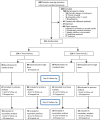High-dose versus standard-dose amoxicillin/clavulanate for clinically-diagnosed acute bacterial sinusitis: A randomized clinical trial
- PMID: 29738561
- PMCID: PMC5940197
- DOI: 10.1371/journal.pone.0196734
High-dose versus standard-dose amoxicillin/clavulanate for clinically-diagnosed acute bacterial sinusitis: A randomized clinical trial
Abstract
Background: The recommended treatment for acute bacterial sinusitis in adults, amoxicillin with clavulanate, provides only modest benefit.
Objective: To see if a higher dose of amoxicillin will lead to more rapid improvement.
Design, setting, and participants: Double-blind randomized trial in which, from November 2014 through February 2017, we enrolled 315 adult outpatients diagnosed with acute sinusitis in accordance with Infectious Disease Society of America guidelines.
Interventions: Standard-dose (SD) immediate-release (IR) amoxicillin/clavulanate 875 /125 mg (n = 159) vs. high-dose (HD) (n = 156). The original HD formulation, 2000 mg of extended-release (ER) amoxicillin with 125 mg of IR clavulanate twice a day, became unavailable half way through the study. The IRB then approved a revised protocol after patient 180 to provide 1750 mg of IR amoxicillin twice a day in the HD formulation and to compare Time Period 1 (ER) with Time Period 2 (IR).
Main measure: The primary outcome was the percentage in each group reporting a major improvement-defined as a global assessment of sinusitis symptoms as "a lot better" or "no symptoms"-after 3 days of treatment.
Key results: Major improvement after 3 days was reported during Period 1 by 38.8% of ER HD versus 37.9% of SD patients (P = 0.91) and during Period 2 by 52.4% of IR HD versus 34.4% of SD patients, an effect size of 18% (95% CI 0.75 to 35%, P = 0.04). No significant differences in efficacy were seen at Day 10. The major side effect, severe diarrhea at Day 3, was reported during Period 1 by 7.4% of HD and 5.7% of SD patients (P = 0.66) and during Period 2 by 15.8% of HD and 4.8% of SD patients (P = 0.048).
Conclusions: Adults with clinically diagnosed acute bacterial sinusitis were more likely to improve rapidly when treated with IR HD than with SD but not when treated with ER HD. They were also more likely to suffer severe diarrhea. Further study is needed to confirm these findings.
Trial registration: ClinicalTrials.gov Identifier: NCT02340000.
Conflict of interest statement
Figures

References
-
- Lemiengre MB, van Driel ML, Merenstein D, Young J, De Sutter AIM. Antibiotics for clinically diagnosed acute rhinosinusitis in adults. Cochrane Database Syst Rev. 2012;10:CD006089 doi: 10.1002/14651858.CD006089.pub4 - DOI - PubMed
-
- Chow AW, Benninger MS, Brook I, Brozek Jl, Goldstein EJC, Hicks LA, et al. IDSA clinical practice guideline for acute bacterial rhinosinusitis in children and adults. Clin Infect Dis. 2012;54(8):e72–e112. doi: 10.1093/cid/cir1043 - DOI - PubMed
-
- File TM Jr., Lode H, Kurz H, Kozak R, Xie H, Berkowitz E, 600 Study Group. Double-blind, randomized study of the efficacy and safety or oral pharmacokinetically enhanced amoxicillin-clavulanate (2,000/125 milligrams) versus those of amoxicillin-clavulanate (875/125 milligrams), both given twice daily for 7 days, in treatment of bacterial community-acquired pneumonia in adults. Antimicrob Agents Chemother. 2004;48(9):3323–3331. doi: 10.1128/AAC.48.9.3323-3331.2004 - DOI - PMC - PubMed
-
- Carenfelt C, Lundberg C. Aspects of the treatment of maxillary sinusitis. Scand J Infect Dis. Suppl 1976;82:78–81. - PubMed
-
- Gehanno P, Darantière S, Dubreuil C, Chobaut JC, Bobin S, Pages JC, et al. A prospective, multicentre study of moxifloxacin concentrations in the sinus mucosa tissue of patients undergoing elective surgery of the sinus. J Antimicrob Chemother. 2002;49:821–826. - PubMed
Publication types
MeSH terms
Substances
Associated data
LinkOut - more resources
Full Text Sources
Other Literature Sources
Medical

